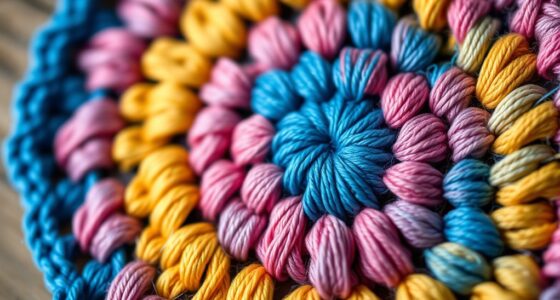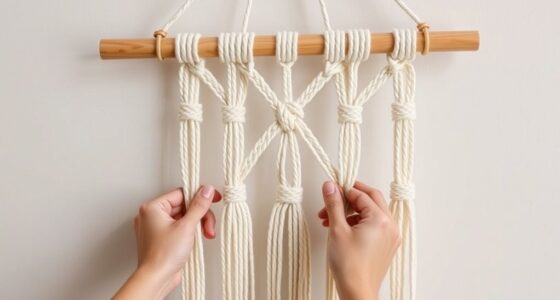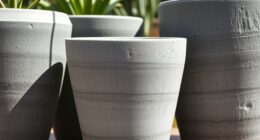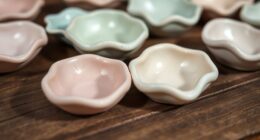To create upcycled denim planter covers with sashiko stitching, start by selecting sturdy, clean denim fabric and measuring your planters for a perfect fit. Cut and sew the material, adding decorative sashiko stitches with contrasting thread to reinforce and embellish. Incorporate trims or embroidery for extra style, then finish with weather-resistant sealants for durability. Place your finished covers outdoors, pairing them with vibrant plants for a charming, sustainable display. Keep exploring for detailed tips to perfect your project.
Key Takeaways
- Collect and prepare durable denim fabric, measuring and cutting pieces to fit planters with reinforced seams for longevity.
- Choose lightweight, breathable planters with drainage holes that complement denim covers visually.
- Apply traditional sashiko stitching with contrasting thread to add decorative patterns and reinforce fabric.
- Add decorative trims, embroidery, or embellishments to personalize and enhance the denim covers’ aesthetic.
- Seal and reinforce finished covers with weather-resistant treatments for durability and outdoor use.
Gathering and Preparing Your Denim Pieces

Before you begin transforming old denim into stylish planter covers, gather all your denim pieces. Look for different shades and textures of denim fabric to add visual interest. Check that each piece is clean and free of tears or stains; you want a sturdy base for your project. Decide on the sizes needed to cover your planters adequately. To add a decorative touch, plan where you’ll incorporate sashiko patterns—these traditional stitching designs will give your planter covers a unique, handcrafted look. Iron your denim pieces to remove wrinkles, making them easier to work with. If your denim is thick, consider cutting it into manageable sections. Proper preparation guarantees your upcycled denim planter covers will be both durable and stylish, ready to showcase your sashiko embroidery. Additionally, selecting high-quality fabrics ensures your project will last longer and maintain its appearance over time, especially since using durable materials can improve the longevity of your finished piece. Incorporating emotional alignment into your creative process can also enhance your enjoyment and satisfaction with the project, making it a more fulfilling experience.
Choosing the Right Planters for Upcycling
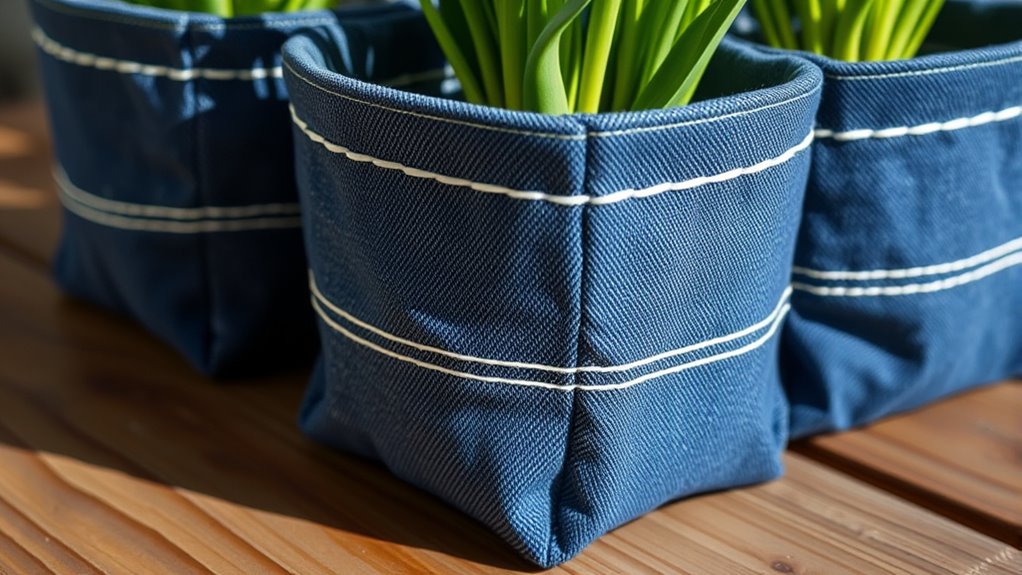
Selecting the right planters is crucial to guarantee your upcycled denim covers fit well and look great. Choose planters made from sustainable materials whenever possible to support eco-friendly practices. Consider the size and shape of your planter to ensure your denim cover fits snugly without gaps, enhancing your upcycling inspiration. Opt for lightweight, breathable planters that allow for proper drainage and airflow, helping your plants thrive. Avoid planters that are too bulky or overly decorative, which can detract from your denim’s texture. Think about how the planter’s color and material complement your denim cover, creating a cohesive look. Using certified sustainable materials can further ensure your project aligns with environmentally responsible practices. Properly managing airflow and drainage in your planters promotes healthier plant growth and extends the life of your denim covers. It’s also helpful to consider planter size and shape to match your existing décor and space constraints. Additionally, selecting planters with drainage holes helps prevent overwatering and root rot, ensuring your plants stay healthy. Use this visual guide to help select the best planters:
| Idea | Consideration |
|---|---|
| Material | Sustainable, breathable options |
| Size | Fits snugly without gaps |
| Drainage | Ensures healthy roots |
| Style | Complements denim and décor |
Cutting and Sewing the Denim Cover
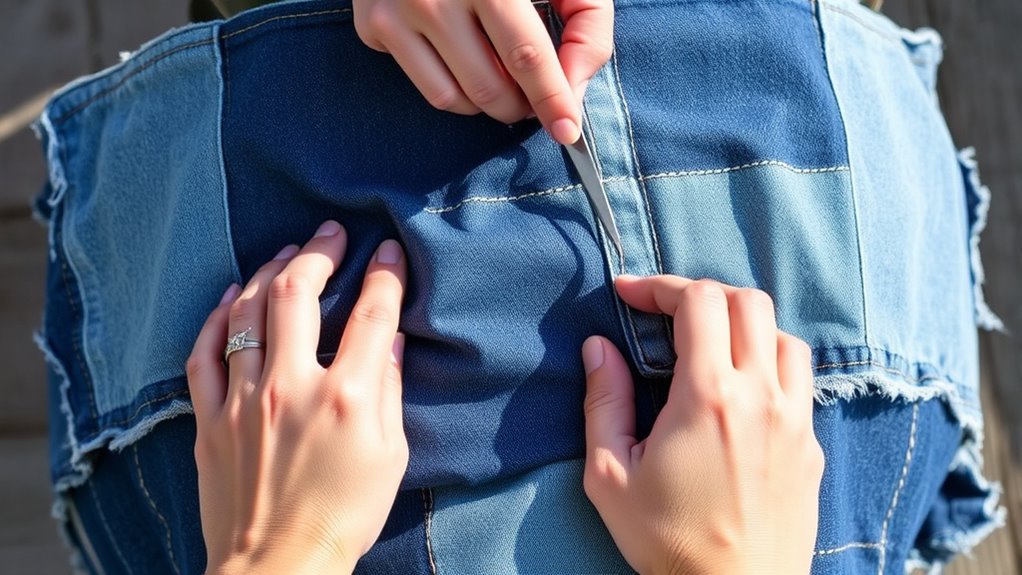
Start by choosing sturdy, suitable denim that can withstand outdoor conditions. Next, measure your planter carefully and mark your fabric to guarantee precise cuts. To ensure the cover fits well, consider the dimensions of your planter and add a small seam allowance. Additionally, pay attention to the fabric quality to ensure durability over time. A weather-resistant denim will help your planter cover last through various outdoor conditions. To further extend the lifespan of your cover, select appropriate sewing techniques that reinforce the seams and prevent fraying. Proper stitching methods can significantly enhance the durability of your project. Finally, cut the denim along your markings, keeping your lines straight for a clean, professional look.
Selecting Suitable Denim
Choosing the right denim is essential for creating a durable and attractive planter cover. You want denim that offers high denim durability, so your cover withstands outdoor conditions and regular watering. Look for sturdy, heavy-weight denim that won’t easily tear or fray over time. Fabric color also matters; selecting denim in neutral tones like indigo, black, or faded blue gives your planter cover a timeless, versatile look. Avoid overly faded or thin fabrics, as they may not hold up well. Check for even color and minimal wear marks, ensuring your project remains attractive and functional. By choosing quality denim with the right durability and color, you’ll create a planter cover that lasts and complements your garden or patio aesthetic.
2. Measuring and Cutting Precisely
To guarantee your denim planter cover fits perfectly, accurate measuring and cutting are essential. Use a ruler or measuring tape to mark precise dimensions, ensuring your measurements account for seam allowances. Proper fabric care means handling the denim gently to prevent fraying, especially when cutting. Sharp sewing tools, like a rotary cutter or sharp scissors, make clean, straight cuts that improve sewing accuracy. Before cutting, double-check your measurements to avoid mistakes, and always cut on a flat, stable surface. Take your time to ensure each piece is symmetrical and well-aligned. Precise cutting reduces the need for adjustments later, helping your sashiko stitching stay neat. Remember, careful measuring and cutting set the foundation for a professional-looking denim cover.
Exploring Sashiko Stitching Techniques

Have you ever wondered how traditional Sashiko stitching transforms simple fabric into intricate, textured designs? Sashiko history dates back centuries, originating in Japan as a practical way to reinforce clothing. Today, it’s celebrated for its beauty and craftsmanship. When exploring Sashiko stitching techniques, you’ll encounter traditional patterns like geometric waves, fans, and floral motifs that tell stories through thread. As you stitch, imagine:
Discover how Sashiko transforms simple fabric into intricate, textured, storytelling designs with rhythmic stitches and contrasting threads.
- Repeating motifs that create rhythmic, mesmerizing patterns
- Fine, even stitches forming textured surfaces
- Contrasting thread colors highlighting the design’s details
- Understanding the basics of how to achieve an even tension and consistent stitch length can enhance the overall appearance of your sashiko projects. Recognizing the importance of thread tension is essential for achieving the characteristic uniformity of sashiko stitches, which is rooted in traditional textile techniques. Maintaining proper tension ensures your stitches stay consistent, resulting in a harmonious design. Additionally, practicing thread tension control helps develop a steady hand and improves stitch quality over time.
Adding Decorative Details and Embellishments

Adding decorative details and embellishments can truly personalize your denim planter covers. You’ll want to select fabrics that complement or contrast your base material, and consider embroidery or trims to enhance the look. These finishing touches make your project stand out and reflect your unique style. Incorporating aromatic accents such as subtle scented trims or essential oil-infused embroidery can also add a sensory dimension to your design. For example, using fabric embellishments inspired by popular desserts like chocolate or sprinkles can give your covers a playful and inviting appearance.
Choosing Embellishment Fabrics
Choosing the right embellishment fabrics can transform your upcycled denim planter covers into truly eye-catching pieces. When selecting fabrics, consider how fabric dyeing can add vibrant colors or unique textures that complement your denim. Pattern designing is essential—opt for fabrics with bold prints, subtle patterns, or textured weaves to create visual interest. Imagine:
- Bright floral prints that pop against the denim background
- Soft, muted textiles for a understated, elegant look
- Textured fabrics like burlap or linen for contrast and depth
Mixing these fabrics thoughtfully enhances your design, making your planter covers stand out. Remember, the goal is to harmonize dyeing techniques and pattern designing to craft a cohesive, attractive finished piece.
Incorporating Embroidered Details
Incorporating embroidered details can instantly elevate your upcycled denim planter covers by adding a personalized and handcrafted touch. Use recycling methods to repurpose scrap fabrics or leftover threads for embroidery, reducing waste. When choosing threads, consider eco-friendly dyes that are free from harmful chemicals, ensuring your project stays sustainable. Embroidery allows you to create intricate designs, patterns, or even meaningful symbols that reflect your style. You can experiment with different stitches to add texture and depth, making each cover unique. These decorative details not only enhance visual appeal but also reinforce the eco-conscious aspect of your project. By combining recycling methods with eco-friendly dyes, your embroidered embellishments become a beautiful statement of sustainability and creativity.
Adding Decorative Trims
Have you considered how decorative trims can transform your upcycled denim planter covers into eye-catching accents? Using embellishment techniques, you can add texture and visual interest easily. Think about sewing on contrasting braid, delicate lace edging, or colorful pom-poms for a playful touch. These decorative accents highlight your craftsmanship and give your project a personalized flair. Visualize a denim cover with a row of bright, embroidered ribbon along the top edge, or a strip of vintage lace framing the bottom. Adding trims isn’t just about aesthetics; it also enhances durability and conceals raw edges. By choosing the right decorative accents, you turn a simple denim cover into a unique, stylish piece that reflects your creative style.
Finishing Touches for a Durable Cover
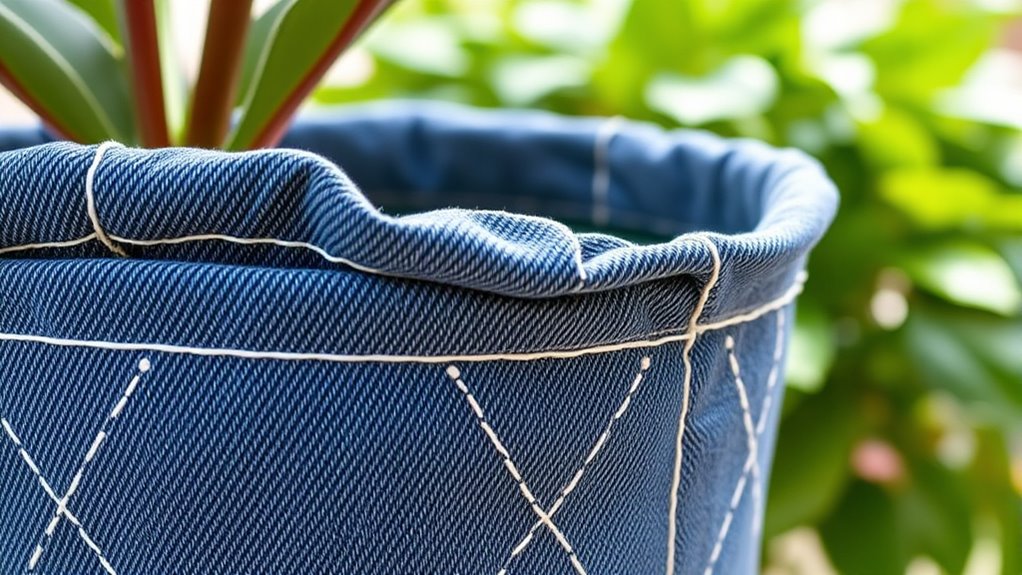
To guarantee your upcycled denim planter cover lasts through the seasons, adding finishing touches that enhance durability is essential. Using sustainable practices, like applying a water-resistant sealant or reinforcing seams with strong stitching, protects your creative reuse from wear and tear. Consider double-stitching key areas to prevent fraying and strengthen the cover’s structure. Sealing the denim with a fabric protector boosts water resistance, keeping your planter dry during rain. Additionally, adding a sturdy backing or lining can provide extra support. These finishing touches ensure your planter cover withstands outdoor conditions while maintaining its appearance. Incorporating UV filters into the sealant can further protect the fabric from sun damage over time. Embracing sustainable practices not only prolongs the life of your creation but also aligns with eco-friendly values, making your upcycled denim project both beautiful and environmentally conscious. Quotes about love and support remind us of the importance of nurturing and caring for our creations and relationships alike.
Styling Tips for Displaying Your Upcycled Planters

Once you’ve finished creating your upcycled denim planter covers, showcasing them effectively can truly highlight your eco-friendly craftsmanship. To style your planters, consider placing them where they catch natural light, like windowsills or outdoor patios, to emphasize their handmade charm. Pair your planters with complementary elements such as rustic wooden surfaces or woven baskets to enhance their eco-friendly appeal. Use plant care to select vibrant, healthy plants that contrast beautifully with the denim covers. Arrange your planters at different heights for visual interest. Incorporate small decorative items like pebbles or twine to add texture. These styling tips help your upcycled denim covers stand out, making your eco-friendly materials a focal point in any space.
Frequently Asked Questions
What Are the Best Types of Denim for Upcycling Projects?
When choosing denim fabric for upcycling projects, you want sturdy, durable materials that can withstand wear and tear. Look for mid-weight or heavy-weight denim, as these are ideal for upcycling materials due to their strength and longevity. Avoid delicate or thin denim, which may not hold up well. Your goal is to repurpose denim fabric into something functional and stylish, making sure it’s thick enough for the project’s needs.
How Can I Prevent the Denim From Fading During Washing?
Ever wondered how to keep your denim vibrant after washing? To prevent fading, you can use fabric preservation methods like washing inside out and opting for cold water. Applying colorfast techniques, such as adding a cup of vinegar or salt during the first wash, helps lock in dye. These steps make sure your denim stays colorful and fresh, extending its life and beauty with just a little extra care.
Are There Eco-Friendly Dyes Suitable for Sashiko Stitching?
You can use eco-friendly dyes suitable for sashiko stitching by exploring natural dyeing methods with plant-based dyes. These dyes are gentle, sustainable, and produce vibrant colors without harming the environment. When you choose natural dyes, you avoid chemical-based options, ensuring your stitching remains eco-conscious. Carefully selecting and applying plant-based dyes allows you to create beautiful, lasting designs while staying true to eco-friendly principles.
How Do I Choose Contrasting Thread Colors for Sashiko?
When choosing contrasting thread colors for sashiko, start by consulting the color wheel to find complementary or bold contrast options. Consider your fabric’s base color and aim for high visibility. Use thicker thread for prominent stitches or thinner for subtle details. Test your chosen colors on scrap fabric first to see how they stand out. This approach guarantees your sashiko stitching creates striking, harmonious designs.
Can These Covers Be Used Outdoors Year-Round?
Think of your planter covers as armor against the elements. For year-round outdoor use, you’ll need to evaluate weather resistance and seasonal durability. Denim can handle some weather, but without treatments, it may fade, weaken, or rot over time. Applying a waterproof sealant or choosing thicker, treated denim boosts their weather resilience, ensuring your covers stand strong through seasons, protecting your plants while maintaining their charm.
Conclusion
With your upcycled denim planter covers, you’re turning everyday materials into a tapestry of creativity and sustainability. Each stitch is a heartbeat of craftsmanship, breathing new life into old denim. As your planters find their place in your space, they become more than decor—they’re stories woven with care and purpose. Embrace this journey of transformation, where your hands craft beauty from the remnants of yesterday, blooming into a vibrant symbol of mindful living.


